10 Symptoms Workplace Stress: Causes, Effects, and Resolutions
Last Updated Nov 7, 2025

Your star employee just snapped at a colleague over a minor email mix-up. Your usually reliable team member has been working until 9 PM every night this week. Meanwhile, that cheerful person from accounting seems completely checked out during meetings.
Though these scenarios might seem like an attitude problem, they’re actually clear signs of stress in the workplace. Once you know how to spot these symptoms, you can make the difference between supporting a struggling employee and losing valuable talent to burnout.
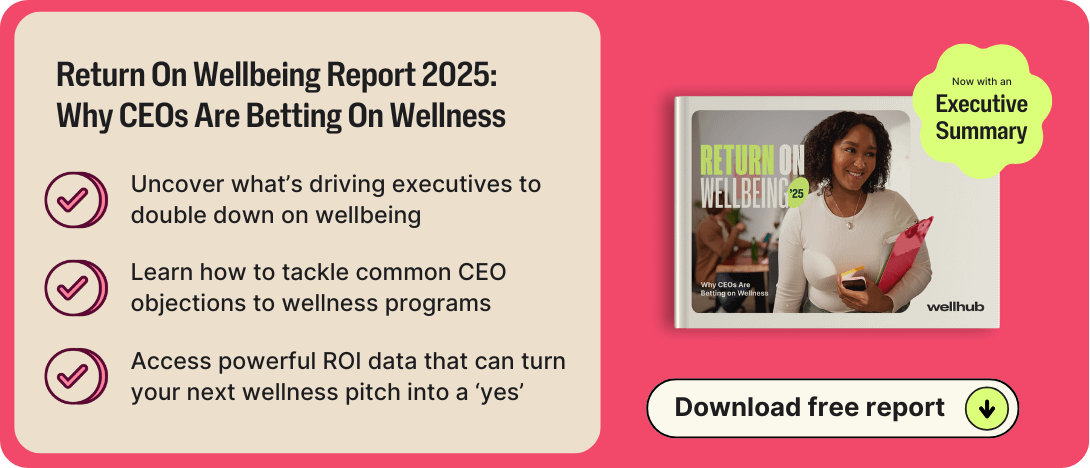
What You'll Learn
- The scope and impact of the 2025 U.S. workplace stress crisis, including burnout rates, economic costs, and health risks.
- The three main types of stress—eustress, acute stress, and chronic stress—and how they affect performance and wellbeing differently.
- The top triggers of workplace stress, from toxic environments and unrealistic workloads to poor management and job insecurity.
- How to recognize the early and less obvious signs of employee stress across physical, emotional, cognitive, and behavioral responses.
- Practical strategies for identifying root causes, implementing quick wins, and building long-term systems to reduce stress and improve culture.
The Status of Stress in the Workplace Today (2025 U.S. Statistics)
The most recent data on workplace stress reveals an American workforce under sustained and intensifying pressure, marking a crisis for both employee wellbeing and business performance.
- Unrelenting and Rising Stress: Chronic workplace stress is now the norm in the U.S., with the majority of employees feeling its effects daily. Burnout rates are at unprecedented levels—82% of employees are at risk, and 77% report experiencing burnout during their current job, often more than once.
- Economic, Policy, and Job Insecurity: Workers are stressed by pervasive economic uncertainty, policy changes, and fears about layoffs. Over half report that job insecurity significantly impacts their stress, with many feeling anxious about the future of their jobs and the time it would take to find new work if laid off.
- Financial and Health Implications: The financial consequences are immense, with burnout costing U.S. businesses $322 billion annually in lost productivity and up to $190 billion in healthcare expenses. Chronic stress also poses significant health risks, from anxiety and depression to heart disease.
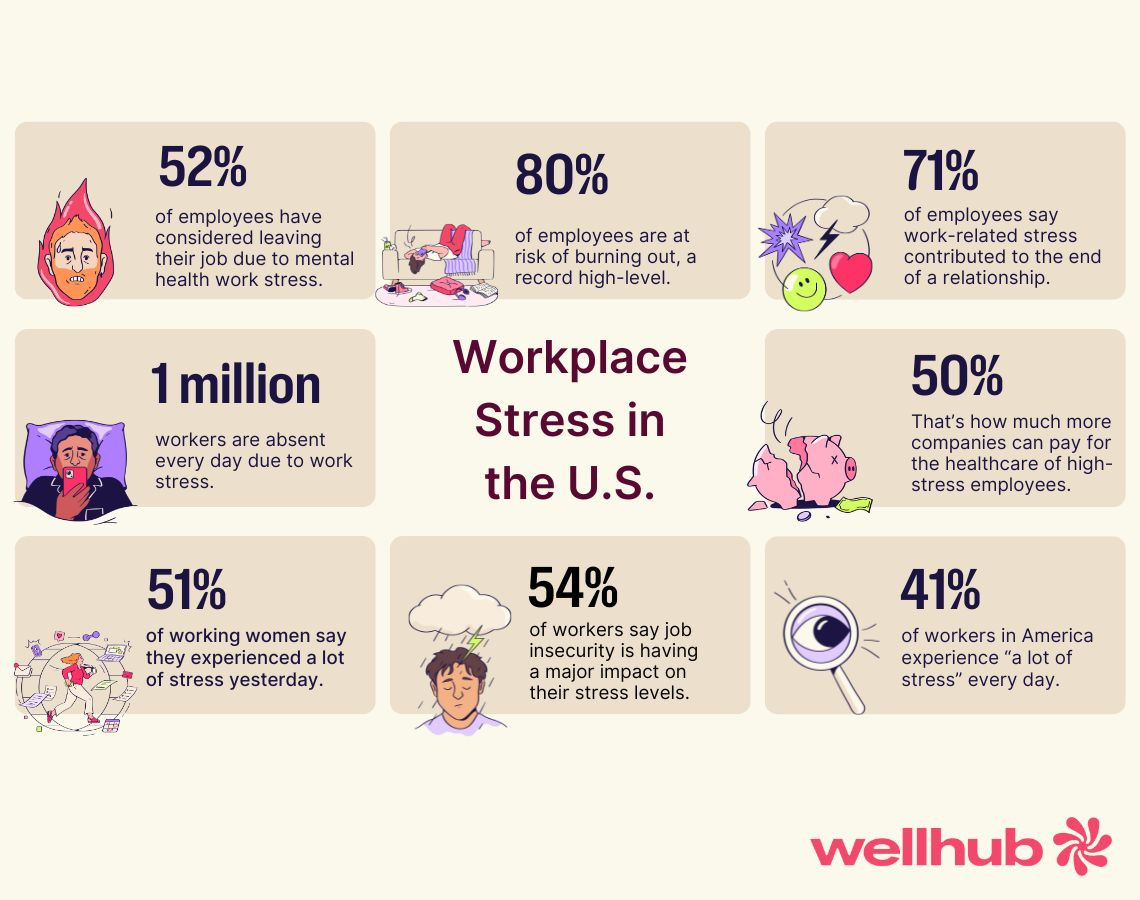
- Generational and Gender Disparities: Younger generations (Gen Z and millennials) are experiencing peak burnout much earlier than previous generations—age 25 versus the historical average of 42. Women are facing higher stress and burnout than men, with the gap more than doubling in recent years.
- Geographic and Industry Variances: Stress levels vary regionally and by industry, with the South ranking highest for workplace stress, especially in states like Georgia, Louisiana, Arkansas, and Texas. Sectors such as healthcare, finance, and insurance are particularly affected.
- Work Environment Factors: Excessive workloads, return-to-office policies, remote work challenges, and lack of mental health support are key drivers of stress. Remote and hybrid workers face unique burdens, including isolation and blurred boundaries between work and home.
- Workforce Engagement at Risk: Only a third of employees report being engaged in their work, and manager engagement is especially low, signaling risks to motivation and productivity.
- Stigma and Support Gaps: While employees desire more mental health support, stigma persists. Many workers remain hesitant to openly discuss mental health issues at work, despite broad support for colleagues' concerns.
In short, U.S. workplaces in 2025 are grappling with a deep-rooted stress and burnout epidemic driven by economic pressures, system-level changes, generational and gender gaps, and evolving work environments. The findings underscore an urgent need for organizations to prioritize mental health support, flexible policies, and proactive measures to protect both employee well-being and business viability.
The 3 Types of Workplace Stress You Should Know About

Stress doesn’t look the same for everyone. This is critical for managers and HR teams to understand. Some stress can fuel productivity and drive people to perform at their best. But other forms of stress? They slowly erode emotional health, decision-making, and job performance.
That erosion is a growing concern for HR leaders. In fact, nearly two-thirds say employee stress and burnout are among their top challenges, according to Paychex research. And it’s easy to see why. Stress touches everything—energy levels, motivation, even how clearly we think.
Think of the colleague who usually catches every detail but starts missing deadlines. It might not be a sign of disengagement. It could be a signal that they’re overwhelmed.
Understanding the different types of stress is the first step in building a healthier workplace. Let’s break them down.
Eustress (Positive Stress)
Eustress is stress with a purpose. It’s the kind that makes you feel energized and focused instead of overwhelmed and defeated. Starting a new role that challenges your skills or learning new technology can all create eustress.
The big difference is that eustress feels manageable and meaningful. You might feel nervous about giving a big presentation, but you’re also excited about the opportunity to show your work. This type of stress can boost performance and contribute to personal growth. But it’s important not to let it get big enough to start impacting you negatively.
Acute Stress
Acute stress hits fast and hard, triggered by immediate challenges that demand your attention right now. Things like tight deadlines that came out of nowhere or last-minute presentations activate your body’s fight-or-flight response and flood you with adrenaline and focus.
While some acute stress here and there can be motivating and push you to perform under pressure to meet those deadlines, it becomes problematic when it happens too frequently. Your body wasn’t designed to constantly work in crisis mode, and being exposed to high-stress situations all the time can gradually wear down your resilience.
Chronic Stress
Chronic stress is the kind that follows you home and greets you every morning when you wake up. Unlike acute stress, which has a clear beginning and end, chronic stress comes from ongoing workplace issues that never seem to get resolved. These things contribute to persistent work pressure:
- Poor management that creates confusion and conflict
- Lack of control over your workload
- Toxic workplace culture
- Job insecurity
Here's how to identify if chronic workplace stress is dragging down your workforce.
What Are the Main Triggers of Work Stress?
Workplace stress goes way beyond having too much on your plate. The real culprits hide in deeper structural or interpersonal issues that make even manageable work demands feel crushing. Job design and workplace culture play big roles in determining whether employees thrive or burn out completely.
Toxic workplace behavior is the strongest predictor of negative employee outcomes, according to research from McKinsey, with one in four employees facing high levels of toxic behavior. These stress triggers are usually caused by the job characteristics themselves or a toxic workplace environment.
The signs of toxic job characteristics are:
- Unrealistic deadlines or workload expectations
- Conflicting demands or role conflict
- Limited opportunities for growth or advancement
And a toxic workplace environment usually looks like:
- Poor communication from management
- Office politics or interpersonal conflict
- Poor working conditions or excessive overtime expectations
Types of Stress Responses in Employees
People react to workplace stress in remarkably different ways. Two employees facing identical challenges might show completely different warning signs, which makes recognizing symptoms of job stress tricky for managers and HR teams.
More than half of employees are experiencing at least moderate levels of burnout, according to SHRM, so it’s important to know how to recognize the signs.
These are the four types of stress responses in employees:
- Physical: Your body tends to show signs of stress at work before your mind catches up, with symptoms like persistent headaches or muscle tension.
- Emotional: Stress can hijack your emotional regulation completely. You might find yourself worried about work during off hours or mood swings that seem disproportionate.
- Cognitive: Mental clarity takes a serious hit under stress. This shows up as forgetfulness about important details or mental fog that makes simple tasks feel impossible.
- Behavioral: Changes in how people act are usually the clearest stress indicators. Watch for withdrawing from colleagues and neglecting personal care and responsibilities.
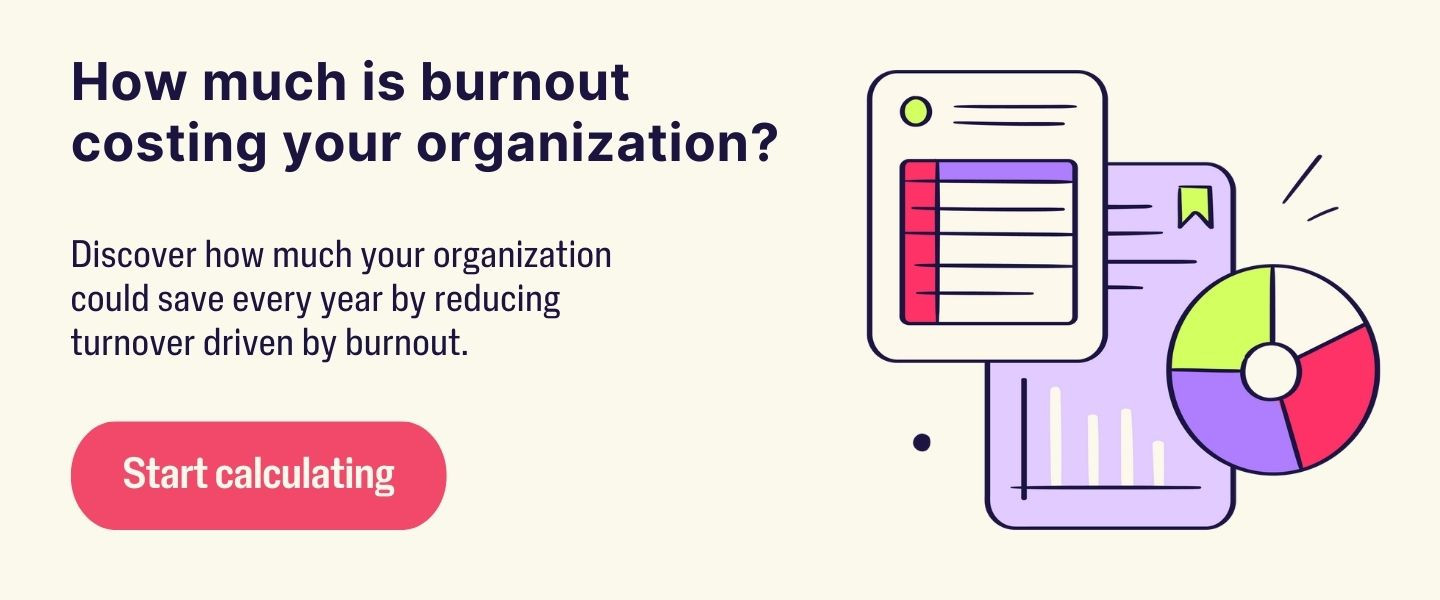
How to Recognize Signs of Workplace Stress in Your Team
Subtle changes in employee behavior can be signs of deeper issues brewing beneath the surface. What looks like a minor shift in attitude or work habits could actually be an early sign of work-related stress that will eventually impact productivity and retention.
Look for these 10 symptoms of stress at work in your team:
Symptom #1: They’re Working Excessively Long Hours
When someone suddenly starts staying late every night or skipping lunch breaks, it might look like dedication. But really, this behavior can be a sign that they feel overwhelmed and believe working more hours is the only way to stay afloat.
Almost 60% of HR professionals reported working beyond their normal capacity in an SHRM survey, which suggests that this is more common than we think.
Symptom #2: They Seem Irritable or on Edge
Previously easygoing team members who now snap at colleagues over minor issues or seem constantly wound up are showing classic emotional stress symptoms. You might notice them withdrawing from office conversations or responding curtly to emails that used to generate friendly exchanges.
Symptom #3: They’re Showing Signs of Exhaustion
Mental and physical fatigue from chronic stress shows up in obvious ways once you know what to look for. Constant yawning during normal work hours or zoning out during meetings are clear signs of exhaustion.
Symptom #4: They’re Detached or Cynical About Work
When stress reaches a certain level, people develop a protective emotional distance from their work. You might hear them expressing unusual negativity about projects they used to care about or showing little interest in team goals or company initiatives.
Symptom #5: They Work Through Breaks
Employees who eat lunch at their desks every day, skip coffee breaks, or use personal time to catch up on work are feeling so behind that stopping feels impossible. This behavior creates a vicious cycle where they can never truly recharge.
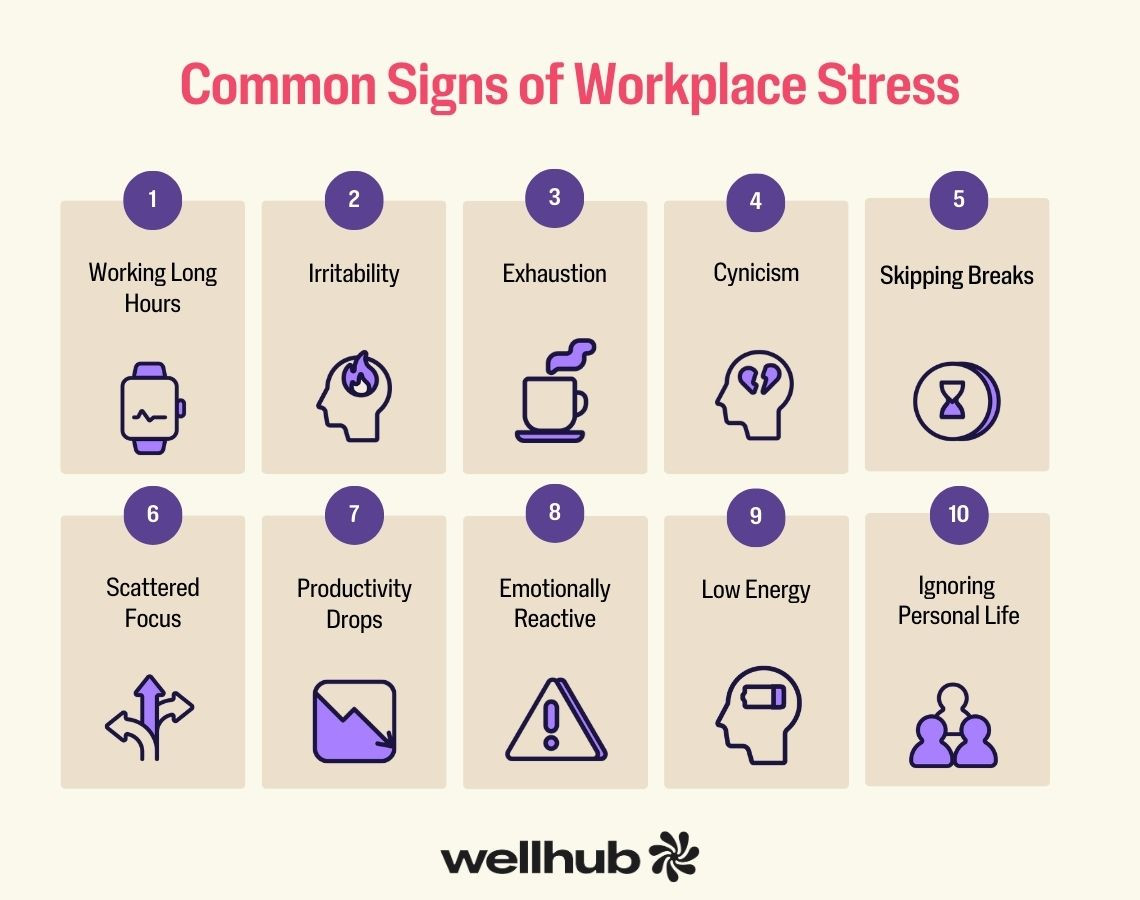
Symptom #6: They Struggle to Focus
Stress hijacks cognitive function in ways that can look like poor work performance or lack of effort. Someone who used to remember details effortlessly might now forget important deadlines or seem confused about instructions they’d normally handle easily.
Symptom #7: Their Productivity or Motivation Drops
When stress overwhelms someone’s capacity to cope, their work quality and output tend to decline noticeably. The quality of their work drops below their usual standards, or they seem generally disengaged from tasks.
Symptom #8: They’re Emotionally Reactive
Previously calm employees who now react emotionally to constructive feedback or seem devastated by minor setbacks are showing signs that stress has compromised their emotional regulation. They might tear up during routine check-ins or become defensive about suggestions for improvement.
Symptom #9: They Frequently Seem Low on Energy
Chronic stress increases cortisol levels and weakens the immune system, according to an article from the Journal of Clinical Medicine. If they’re frequently dealing with health conditions or complain about feeling run down, stress might be the culprit.
Symptom #10: They’re Pulling Away From Life Outside of Work
People tend to abandon personal activities that normally recharge them when job stress becomes overwhelming. They might stop going to the gym, skip social events, give up hobbies, or even neglect personal hygiene activities like getting a haircut. Not taking the time for these activities creates an unhealthy cycle where they have fewer outlets for stress relief.
Workplace stress isn't harmless — dive deep into the consequences of workplace stress.
Don’t Stop at the Obvious Signs
Stress doesn’t always announce itself with dramatic meltdowns or obvious employee burnout symptoms. Some of your most stressed employees might be the ones who seem to have everything together on the surface, while others express their stress in ways that don’t match what you’d expect from workplace wellness guides. The employees who never complain and always meet deadlines might be struggling the most.
Regular check-ins and real conversations can help you see some of these nontraditional stress patterns:
- The overachiever who never says no: They take on extra projects without being asked and seem motivated, but they might be driven by anxiety about job security.
- The employee with perfect attendance: Someone who never takes sick days or vacation time might be afraid to step away from work, even when they desperately need rest.
- The quiet team member: Withdrawn behavior could signal stress, but it might also be someone’s natural response to feeling overwhelmed.
- The helpful colleague: Someone who constantly tries to help others might be avoiding their own heavy workload or seeking validation.
What to Do if You Notice Signs of Employee Stress
If you notice signs of stress in your employees, remember that individual struggles can reflect broader organizational challenges that need systematic solutions. Employee stress can signal that there are problems with workload distribution or that your company culture needs attention.
The financial and cultural costs of unaddressed workplace stress add up quickly. High-stress environments drive up turnover rates, increase stress leave requests, and lead to higher sickness absence rates. Employee stress is positively correlated with turnover rates, according to a 2024 study in Frontiers in Psychology.
Taking action early prevents small stress issues from becoming huge organizational issues. You’re addressing individual employee needs while strengthening your entire workplace culture. Here’s how:
Identify the Root Causes
The first thing you’ll want to do is understand what’s actually causing employee stress. Many organizations make the mistake of providing generic wellness programs without looking into the specific issues that affect their team.
Here are five ways to identify stress triggers:
- Regular one-on-one check-ins: Schedule consistent meetings with team members to talk about workload and job satisfaction in a safe environment.
- Anonymous pulse surveys: Use brief, frequent surveys to gauge stress levels and identify patterns across departments.
- Exit interviews that dig deeper: When people leave, ask specific questions about stress factors and organizational issues.
- Open Feedback forums: Create structured opportunities for employees to share concerns about workload distribution and expectations.
- Cross-departmental collaboration reviews: Analyze how different teams work together to identify bottlenecks or communication breakdowns.
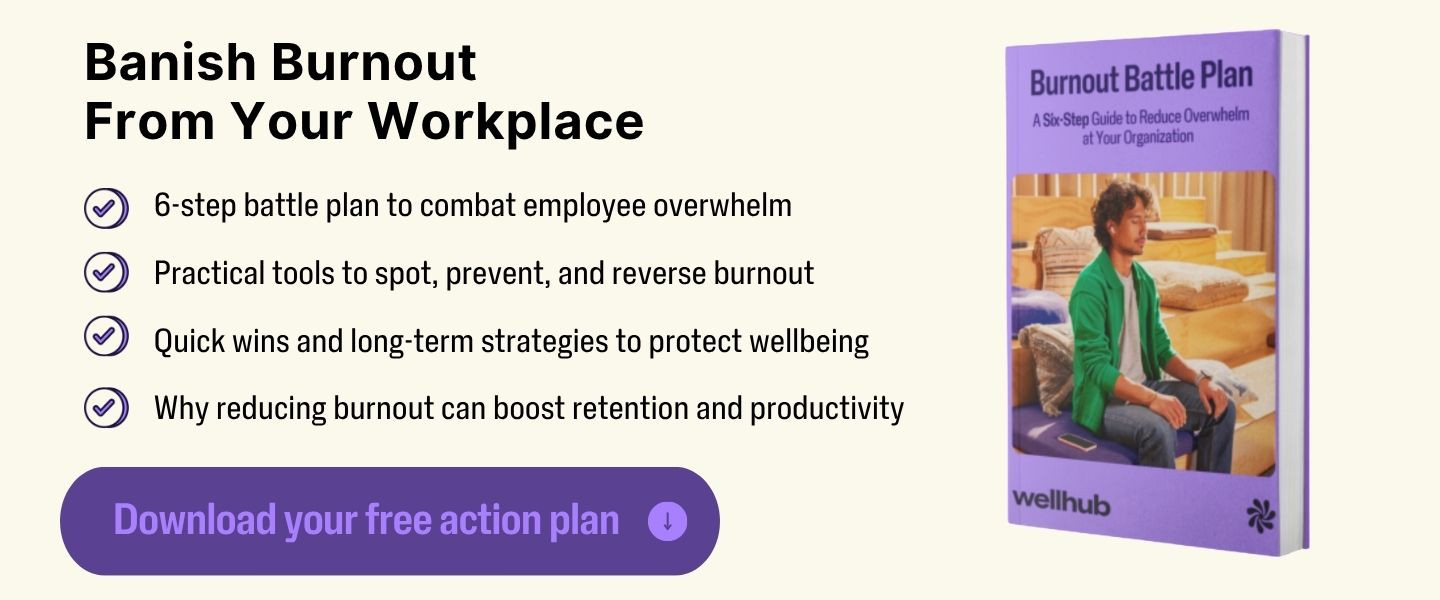
Start Making Changes
Once you understand the root causes, focus on implementing immediate relief measures and longer-term systemic improvements. Quick wins help employees feel heard and supported while you work on bigger organizational changes.
Start with changes you can implement immediately, like encouraging people to take their lunch break or providing mental health days. Set up meeting-free periods during the day so people can catch up on work. These small adjustments give people a chance to breathe and show that leadership takes stress seriously.
Longer-term solutions take more time to work, but come with bigger improvements. Consider restructuring workload distribution to prevent chronic overwork or offer flexible scheduling options that help employees manage work-life balance.
Equip Employees With Tools to Manage Stress
Giving employees tools to manage stress builds resilience and a better company culture. The most successful wellness programs combine systemic workplace improvements with mental health support. Try providing access to these stress management tools:
- Mindfulness and meditation apps: Give them subscriptions to apps that teach breathing techniques or guided meditations.
- Stress management workshops: Host sessions that teach practical skills like time management and healthy coping strategies led by qualified professionals.
- Mental wellness coaching: Provide access to professional support through employee assistance programs.
- Physical wellness options: Include gym memberships or other physical activities that help employees release tension and build stress resilience.
- Financial wellness resources: Since financial stress can spill into workplace performance, provide budgeting workshops or debt management resources.
Holistic Wellness Programs Can Help Prevent Workplace Stress
Workplace stress shows up in many ways beyond the obvious burnout symptoms. Spotting these warning signs early will let you address the real organizational issues creating pressure for your team.
Employee wellbeing programs tackle stress at its source while giving people the tools they need to succeed in their daily challenges. When employees have the stress management tools they need to handle their mental health problems, everyone wins with lower turnover and a healthier workplace culture.
Speak with a Wellhub specialist to see how our employee wellbeing programs can support your team to prevent unhealthy stress.

Company healthcare costs drop by up to 35% with Wellhub*
See how we can help you reduce your healthcare spending.
[*] Based on proprietary research comparing healthcare costs of active Wellhub users to non-users.
Category
Share

The Wellhub Editorial Team empowers HR leaders to support worker wellbeing. Our original research, trend analyses, and helpful how-tos provide the tools they need to improve workforce wellness in today's fast-shifting professional landscape.
Subscribe
Our weekly newsletter is your source of education and inspiration to help you create a corporate wellness program that actually matters.
Subscribe
Our weekly newsletter is your source of education and inspiration to help you create a corporate wellness program that actually matters.
You May Also Like

FSA vs. HSA Strategy for HR Leaders | Wellhub
Compare FSA vs HSA rules, tax advantages, eligibility, and rollover differences to help employees choose the right account and avoid costly compliance issues.

Employee Wellness Programs: Key Components for Success | Wellhub
Transform your workplace wellness strategy by integrating physical, mental, financial, and social wellbeing into a comprehensive wellness program that works

Benefits Strategy Roadmap: Pull and Retain Top Talent | Wellhub
Support wellbeing, reduce turnover, and maximize ROI with a benefits strategy built for today’s workforce—not yesterday’s spreadsheet.